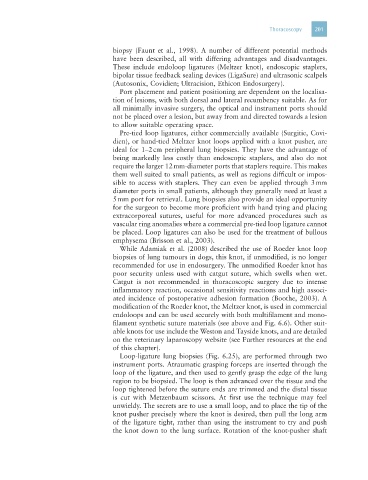Page 213 - Clinical Manual of Small Animal Endosurgery
P. 213
Thoracoscopy 201
biopsy (Faunt et al., 1998). A number of different potential methods
have been described, all with differing advantages and disadvantages.
These include endoloop ligatures (Meltzer knot), endoscopic staplers,
bipolar tissue feedback sealing devices (LigaSure) and ultrasonic scalpels
(Autosonix, Covidien; Ultracision, Ethicon Endosurgery).
Port placement and patient positioning are dependent on the localisa-
tion of lesions, with both dorsal and lateral recumbency suitable. As for
all minimally invasive surgery, the optical and instrument ports should
not be placed over a lesion, but away from and directed towards a lesion
to allow suitable operating space.
Pre-tied loop ligatures, either commercially available (Surgitie, Covi-
dien), or hand-tied Meltzer knot loops applied with a knot pusher, are
ideal for 1–2 cm peripheral lung biopsies. They have the advantage of
being markedly less costly than endoscopic staplers, and also do not
require the larger 12 mm-diameter ports that staplers require. This makes
them well suited to small patients, as well as regions difficult or impos-
sible to access with staplers. They can even be applied through 3 mm
diameter ports in small patients, although they generally need at least a
5 mm port for retrieval. Lung biopsies also provide an ideal opportunity
for the surgeon to become more proficient with hand tying and placing
extracorporeal sutures, useful for more advanced procedures such as
vascular ring anomalies where a commercial pre-tied loop ligature cannot
be placed. Loop ligatures can also be used for the treatment of bullous
emphysema (Brisson et al., 2003).
While Adamiak et al. (2008) described the use of Roeder knot loop
biopsies of lung tumours in dogs, this knot, if unmodified, is no longer
recommended for use in endosurgery. The unmodified Roeder knot has
poor security unless used with catgut suture, which swells when wet.
Catgut is not recommended in thoracoscopic surgery due to intense
inflammatory reaction, occasional sensitivity reactions and high associ-
ated incidence of postoperative adhesion formation (Boothe, 2003). A
modification of the Roeder knot, the Meltzer knot, is used in commercial
endoloops and can be used securely with both multifilament and mono-
filament synthetic suture materials (see above and Fig. 6.6). Other suit-
able knots for use include the Weston and Tayside knots, and are detailed
on the veterinary laparoscopy website (see Further resources at the end
of this chapter).
Loop-ligature lung biopsies (Fig. 6.25), are performed through two
instrument ports. Atraumatic grasping forceps are inserted through the
loop of the ligature, and then used to gently grasp the edge of the lung
region to be biopsied. The loop is then advanced over the tissue and the
loop tightened before the suture ends are trimmed and the distal tissue
is cut with Metzenbaum scissors. At first use the technique may feel
unwieldy. The secrets are to use a small loop, and to place the tip of the
knot pusher precisely where the knot is desired, then pull the long arm
of the ligature tight, rather than using the instrument to try and push
the knot down to the lung surface. Rotation of the knot-pusher shaft

